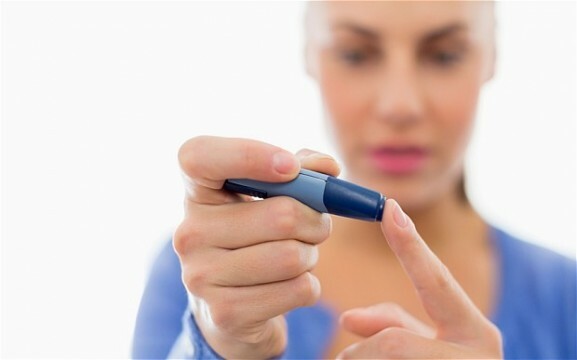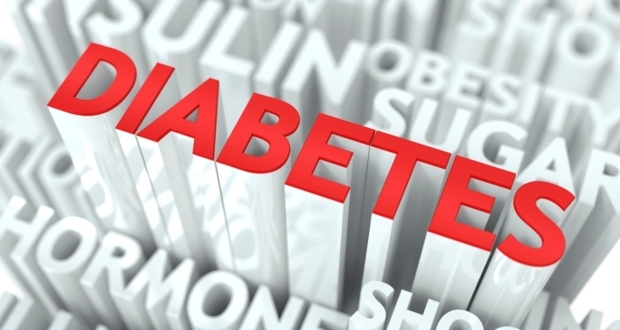Diabetes mellitus is a chronic hyperglycemia, which arises from an absolute, or relative lack of insulin.
Types of diabetes

Insulin-dependent diabetes mellitus type I: occurs in young people under 40 years of age, and is genetically determined. The main provoking factors are viruses and antibodies , which provoke damage to B cells of the pancreas, and a violation of the secretion of insulin.
Non-insulin-dependent diabetes mellitus type II: is found mainly in people after 40 years. The cause of development is a decrease in the sensitivity of receptors to insulin, which often occurs in people who are obese. In this type of diabetes, the level of insulin in the blood is normal at first, then rises slightly, then decreases below the established level( due to depletion of B cells of the pancreas).
Clinical and biochemical signs of diabetes
Hyperglycemia: occurs due to insulin deficiency 9, reduced glucose delivery to cells of insulin-dependent tissues, reduced glucose utilization, synthesis of glycogen and fats, activation of gluconeogenesis).
Glycosuria: occurs when hyperglycemia exceeds the renal threshold.
Polyuria ( increased daily urine volume greater than 2 liters): due to the excretion of glucose in the urine( with 1 g of glucose, 40 ml of urine is excreted).
Polydipsia: is due to an increase in osmotic blood pressure( due to hyperglycemia), and causes irritation of the osmoreceptors of the hypothalamus, as well as a decrease in the volume of circulating blood( due to polyuria), which leads to irritation of the hypothalamic baroreceptors. Weight loss: is associated with increased catabolic processes( because insulin is an anabolic hormone).
Ketonemia and ketonuria ( the amount of ketone bodies in urine and blood): due to the increased level of acetyl-CoA( due to the increased disintegration of fats) and a decrease in the level of oxaloacetate( gluconeogenesis), which is necessary for complete oxidation of acetyl-CoA.Excess acetyl-CoA is utilized by conversion to ketone bodies.
However, how can an ordinary person determine if he suffers from this disease? The line between norm and deviation is very thin. In most cases, the symptoms develop very quickly, so it is important to keep up with the changes in the body.
First signs of diabetes mellitus type I

- Uncontrolled thirst: a person consumes 3 to 5 liters of fluid per day.
- In the breath there is a smell of acetone, which indicates an increase in the level of ketone bodies.
- Increased appetite. The patient eats a lot, but his body weight decreases dramatically.
- Frequent and profuse urination, especially at night.
- Skin regeneration is impaired.
- The emergence of fungal diseases and furunculosis. Often type I diabetes occurs as a result of a viral illness, or due to stress.
The first signs of type II diabetes
- Common symptoms: rapid fatigue, poor memory, sharp drop in vision.
- Itching, the appearance of fungal diseases, skin regeneration is disrupted.
- Strong thirst( as in type I diabetes).
- Frequent urination.
- Ulcers on the legs, numbness, severe pain while walking.
- Thrush in women.
- Weight loss in advanced stages. As a rule, during the development of this disease, both I and II types are determined by several stages.
Stages of development of the
SD Prediabet, or the initial stage of
At this stage, there are no discrepancies in the norm. Conditionally, this stage is affected by all who are at risk of further progress of the disease. For example, a patient with obesity can be referred to this stage even without the appearance of clinical signs. This stage of medicine is allocated in order to prevent further development of the disease.
Hidden Diabetes
There are no clinical signs during this stage. Blood and urine tests do not show any abnormalities, however, the glucose-tolerance reaction finds changes: the dynamics of blood sugar level increase after application of a glucose load is much lower than at the norm. Patients at this stage require close supervision.
Explicit diabetes
Characterized by obvious clinical symptoms, which are confirmed by laboratory tests. After you have noticed the symptoms described above, you should contact the doctor for the examinations. The most common way to diagnose this disease is a glucose tolerance test.
In humans, after a fasting at night, the glucose level is determined. After that he receives 75 grams of oral.glucose( as a solution), and every half hour for 2 hours determine the blood glucose level. According to the results obtained, sugar curves are built. In healthy people, the sugar curve rapidly increases, and it quickly falls off, and after 2-2.5 hours the level is less than the initial data. At the same time, the sugar curve slowly increases in patients, after which a plateau sets in, and then slowly decreases, and after 2 hours the level will exceed the initial values.
According to modern requirements, glucose tolerance is assessed by determining its level on an empty stomach, and 2-2.5 hours after a glucose breakfast. Diagnosis of diabetes mellitus is determined if the fasting glucose content is greater than 6.0 mmol / l, and 120 minutes after glucose breakfast will exceed 11.1 mmol / l. Tolerance tolerance is indicated by the fasting glucose level below 6.0 mmol / l, and 2-3 hours after glucose enrichment - 7.9 - 11.1 mmol / l.
This disease can also be diagnosed by determining the content of glycosylated hemoglobin( an indicator of prolonged hyperglycemia).Glucose has a reactive aldehyde group, due to which it is attached to proteins, including hemoglobin. Normally, the level of glycosylated hemoglobin does not exceed 5%.An increase in its level indicates an increase in the level of glucose, which lasts at least 90 days. This indicator is most often used to study the effectiveness of diabetes treatment.
Prevention of diabetes mellitus
It is almost impossible to influence the dynamics of growth of type I diabetes, as the main causes of its appearance are the hereditary factor, as well as the viruses that surround us everywhere. Nevertheless, after much research, scientists managed to prove that the risk of developing this disease in children who were breastfed lower than those fed with nutrient mixtures.
But with the prevention of type II diabetes things are different. To full-fledged preventive measures, the following can be attributed: normalization of body weight, and following a diet in the future;control of lipid metabolism and blood pressure;correct separate food, with a minimum intake of carbohydrates;physical loads in metered quantities.
To cure this disease, only taking tablets, it is impossible. The main treatment is compliance with a diet where low levels of fat and carbohydrates. Diet is the only restriction for diabetics, because it allows you to keep your cholesterol levels in the normal state. Also, the patient should take insulin the required number of times per day.
Poor performance in the treatment of non-compliance with diet, and violations of the intake of insulin doses. Strengthening the insulin regime is necessary in order to bring the body back to normal as quickly as possible, and to avoid any complications.



